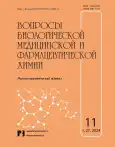Biological activity of iron chelates based on Bacillus sp. Problems of biological, medical and pharmaceutical chemistry
- Authors: Sizentsov A.N.1, Galaktionova L.V.1, Davydova O.K.1, Hovrina T.D.1, Kryunkina V.S.1
-
Affiliations:
- Orenburg State University
- Issue: Vol 27, No 11 (2024)
- Pages: 48-55
- Section: Bioelementology
- URL: https://journal-vniispk.ru/1560-9596/article/view/271778
- DOI: https://doi.org/10.29296/25877313-2024-11-06
- ID: 271778
Cite item
Abstract
Introduction. Iron is one of the most important essential elements for all living organisms and one of the most common metals in the earth's crust and soils.
The aim of the work: to evaluate the biological activity of iron chelate complexes obtained by the method of targeted bacterial synthesis based on soil isolates of Bacillus sp., in relation to bacteria, fungi and higher plants.
Material and methods. Soil samples taken near quarries of non-ferrous and ferrous metallurgy mining enterprises (quarry of PJSC Gaisky Mining and Processing Plant, quarry and "blue" lake of the Blyavinsky copper-pyrite deposit of OOO MMSC, Orenburg region) served as a source of metal-resistant strains of Bacillus sp. The diffusion method of agar wells, serial dilutions, "replicas" were used, phytotesting was carried out in accordance with ISO 11269-2:2012 and GOST 12038-84.
Results. The obtained in the process of one-stage interaction of the destructured biomass of the B. cereus sample Cu pit with a solution of FeSO4×7H2O (precursor) at a concentration of 0.125 M in a ratio of 1:10 has a high potential for use as a bactericidal complex characterized by a pronounced inhibitory effect on S. aureus and P. aeruginosa (p < 0.01). In a model experiment on Triticum aestivum and Sinapis alba, a reliably significant stimulation of the formation of chlorophyll a and b of both test cultures and an increase in compensatory mechanisms with an increase in their stress resistance were recorded. The study of fungicidal activity of test samples of biomaterial B. cereus Cu pit in combination with FeSO4×7H2O 0.250 M completely suppresses the growth of the studied fungi.
Conclusions. The potential for using chelate complexes based on the iron-resistant strain B. cereus Cu pit is due to the level of its biological activity depending on the concentration of the introduced precursor.
Full Text
##article.viewOnOriginalSite##About the authors
A. N. Sizentsov
Orenburg State University
Author for correspondence.
Email: asizen@mail.ru
ORCID iD: 0000-0003-1099-3117
Ph.D. (Biol.), Associate Professor of the Department of Biochemistry and Microbiology
Russian Federation, OrenburgL. V. Galaktionova
Orenburg State University
Email: anilova.osu@mail.ru
ORCID iD: 0000-0003-0781-3752
Ph.D. (Biol.), Associate Professor, Head of the Department of Biology and Soil Science
Russian Federation, OrenburgO. K. Davydova
Orenburg State University
Email: okdavydova@yahoo.com
ORCID iD: 0000-0002-1067-0337
Ph.D. (Biol.), Associate Professor of the Department of Biochemistry and Microbiology
Russian Federation, OrenburgT. D. Hovrina
Orenburg State University
Email: erachina.tatiana@gmail.com
ORCID iD: 0009-0008-0723-9192
Master's Student
Russian Federation, OrenburgV. S. Kryunkina
Orenburg State University
Email: violettakryunkina@yandex.ru
ORCID iD: 0009-0009-4193-9368
Master's Student
Russian Federation, OrenburgReferences
- Rizzi A., Roy S., Bellenger J.P. et al. Iron Homeostasis in Bacillus subtilis Requires Siderophore Production and Biofilm Formation. Appl Environ Microbiol. 2019 Jan 23; 85(3): e02439-18. doi: 10.1128/AEM.02439–18.
- Roy E.M., Griffith K.L. Characterization of a Novel Iron Acquisition Activity That Coordinates the Iron Response with Population Density under Iron-Replete Conditions in Bacillus subtilis. J Bacteriol. 2016 Dec 13; 199(1): e00487–16. doi: 10.1128/JB.00487-16.
- Fukushima T., Allred B.E., Sia A.K. et al. Gram-positive siderophore-shuttle with iron-exchange from Fe-siderophore to apo-siderophore by Bacillus cereus YxeB. Proc Natl Acad Sci U S A. 2013 Aug 20; 110(34): 13821–6. doi: 10.1073/pnas.1304235110.
- Ji C., Juárez-Hernández R.E., Miller M.J. Exploiting bacterial iron acquisition: siderophore conjugates. Future Med Chem. 2012 Mar; 4(3): 297–313. doi: 10.4155/fmc.11.191.
- Wang D., Zhan Y., Cai D. et al. Regulation of the Synthesis and Secretion of the Iron Chelator Cyclodipeptide Pulcherriminic Acid in Bacillus licheniformis. Appl Environ Microbiol. 2018 Jun 18; 84(13): e00262–18. doi: 10.1128/AEM.00262–18.
- McMillan D.G., Velasquez I., Nunn B.L. et al. Acquisition of iron by alkaliphilic bacillus species. Appl Environ Microbiol. 2010 Oct; 76(20): 6955–61. doi: 10.1128/AEM.01393-10.
- Yan Q., Lin X., Chen Z. et al. Biosynthesis of bionanomaterials using Bacillus cereus for the recovery of rare earth elements from mine wastewater. J Environ Manage. 2023 Mar 1; 329: 117098. doi: 10.1016/j.jenvman.2022.117098.
- Solovchenko A., Selyakh I., Semenova L. et al. A local or a stranger? Comparison of autochthonous vs. allochthonous microalgae potential for bioremediation of coal mine drainage water. Chemosphere. 2024 Sep 17; 365: 143359. doi: 10.1016/j.chemosphere.2024.143359.
- ISO 11269-2, Soil quality — Determination of the effects of pollutants on soil flora – Part 2: Method for the measurement of inhibition of root growth (Качество почвы. Определение воздействия загрязняющих веществ на флору почвы. Часть 2. Воздействие контаминированной почвы на прорастание и ранний рост высших растений).
- ГОСТ 12038-84 Межгосударственный стандарт. Семена сельскохозяйственных культур. Методы определения всхожести. Методы отбора проб. Москва: Стандартинформ, 2011. 121 с. [GOST 12038-84 Mezhgosudarstvennyj standart. Semena sel'skohozjajstvennyh kul'tur. Metody opredelenija vshozhesti. Metody otbora prob. Moskva: Standartin-form, 2011. 121 s. (In Russ.)].
- Andreazza R., Bortolon L., Pieniz S. et al. Phytoremediation of Vineyard Copper-Contaminated Soil and Copper Mining Waste by a High Potential Bioenergy Crop (Helianthus annus L.). Journal of Plant Nutrition. 2015 38(10): 1580–1594; https://doi.org/10.1080/01904167.2014.962702.
- Parida A.K., Kumari A., Panda A. et al. Photosynthetic pigments, betalains, proteins, sugars, and minerals during Salicornia brachiata senescence. Biologia plantarum. 2018; 62(2): 343–352. doi: 10.1007/s10535-017-0764-1.
- Wilkins D. The measurement of tolerance to edaphic factors by means of root growth. New Phytologist. 1978; 80: 623–33.
Supplementary files








